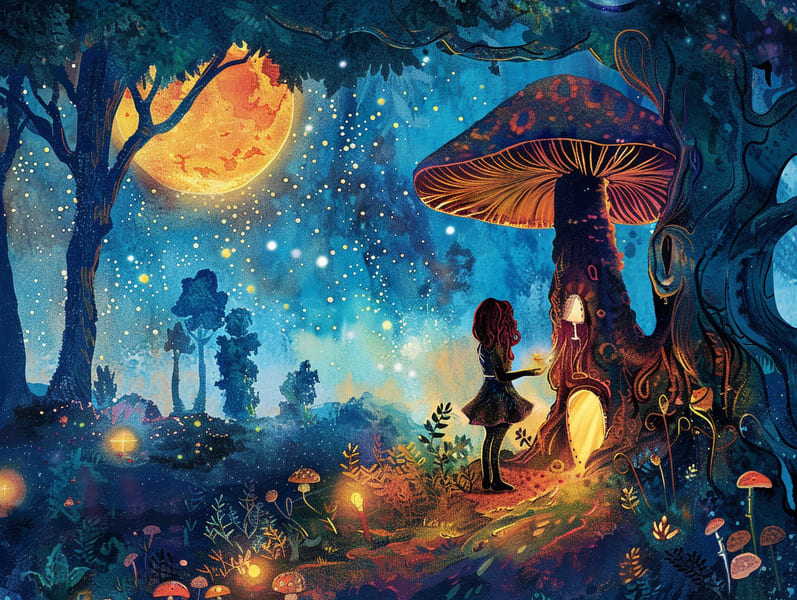The Journey of Short Fairy Tales and Their Eternal Allure.
The Journey of Short Fairy Tales and Their Eternal Allure.
Blog Article

Old fairy tales have old origins. These tales have been passed down from one generation to the next far before they were ever published. They developed from a variety of traditions, including Indigenous traditions. They were initially narrated among adults, often carrying themes and messages aligned with the societal norms and beliefs of the time.
The Grimm brothers, the two Grimm brothers, were among the first to compile many of these beloved narratives. Their published works, "Grimm's Fairy Stories," included stories like "Cinder Maid," "The Bread Crumb Trail," and "Schneewittchen," which have since become cornerstones in the world of classic fairy tales. Similarly, H. C. Andersen's imaginative fairy tales, such as "The Sea Maid," and "The Little Duckling," have enchanted hearts worldwide, cementing their place in the pantheon of classic fairy tales.
Despite their age, fairy tales remain as meaningful as ever, especially as bedtime stories for kids. These delightful tales are now available in multiple formats, including vividly illustrated books, delightful animations, and internet fairy tales.
Their continued relevance can be ascribed to several captivating elements:
Moral Lessons: Old fairy tales often convey important moral lessons. Stories like "The Wolf and the Liar" teach the value of sincerity, while "The Hare and the Tortoise" underline the traits of persistence and unassuming nature. These narratives offer children clear distinctions between right and wrong, shaping their moral compass in a soft yet profound way.
Compassion and Insight: Old fairy tales frequently showcase individuals facing difficulties and adversities, fostering readers to sympathize with their struggles and champion their triumphs. For instance, "The Story of Beauty and the Beast" points out the significance of looking beyond appearances to know the inner self of a individual, promoting empathy and perception.
Cultural Comprehension: Many fairy tales are interwoven with the cultural contexts from which they were born. Exploring these tales can provide informative snapshots into different heritages, encouraging a sense of world awareness and recognition.
Fantasy and Innovation: The magical elements in timeless fairy tales—spells and potions—boost children’s imaginative ideas. These stories take readers to otherworldly realms, unleashing inventive dreams and a sense of fascination that remains a lifetime.
Traditional fairy tales are not only whimsical but also illuminating. They act as bewitching tools in fostering various thinking and feeling skills in children. When fairy tales are told out loud, they advance language acquisition by introducing new vocabulary and complicated sentence structures. This practice also promotes listening skills and focus, as children pay close attention, anxious to see what happens next.
Furthermore, debating the themes and characters of traditional fairy tales can cultivate thinking skills and evaluative skills. The young are instructed to find patterns, foresee events, and realize cause and effect. These deliberations also benefit kids say their thoughts and feelings, adding to their emotional intelligence.
In today’s cyber age, the existence of online fairy tales has made these fairy tales more within reach than ever. Web-based platforms and online apps give ample collections of children's fairy tales that can be looked at or listened through anytime, anywhere. Fairy tales narrated are particularly common, extending an interactive way for kids to take part in these fantastical tales. Read-aloud stories and narrated videos carry characters and settings to life, often enhanced by bewitching harmonies and harmonies that heighten the storytelling experience.
The timeless charm of timeless fairy tales lies in their ability to evolve to changing times while keeping hold of their central messages. Contemporary revisions of these narratives often spotlight more diverse characters and modern settings, making them familiar to today’s audience. However, the basic principles of fortitude, humanity, and truth remain unchanged, continuing to appeal to readers of all ages.
Fairy tales also offer a sense of calm and familiarity. They feature a neat narrative with a apparent beginning, middle, and end, often ending with the resolution of conflicts and the triumph of virtue over wickedness. This certainty can be placating for kids, gifting a sense of steadfastness in an variable world.
Traditional fairy tales continue to delight and guide new generations, maintaining their appeal and impact in modern society. As bedtime stories for kids, they confer a perfect blend of fantasy and learning, enriching moral values, empathy, and creativity. The presence of digital fairy tales and the in demand status of fairy tales spoken guarantee that these ancient stories remain accessible to new generations.
By continuing and recounting these fairy tales, we continue to pay tribute to the rich tapestry of storytelling and cultural heritage. Whether you are seeing a beautifully illustrated book, browsing a electronic collection, or listening to an voice book, the loveliness of Grimm's fairy tales is always within reach. These stories demonstrate of the everlasting essence of fairy tales and its ability check here to unite us across epochs and places.
Even if you are accessing a beautifully illustrated book, accessing a online collection, or listening through an read-aloud book, the delight of classic fairy tales is always within reach.
These stories show us of the enduring influence of narratives and its ability to bond us across centuries and lands, forging a link that fascinates and enlightens alike.